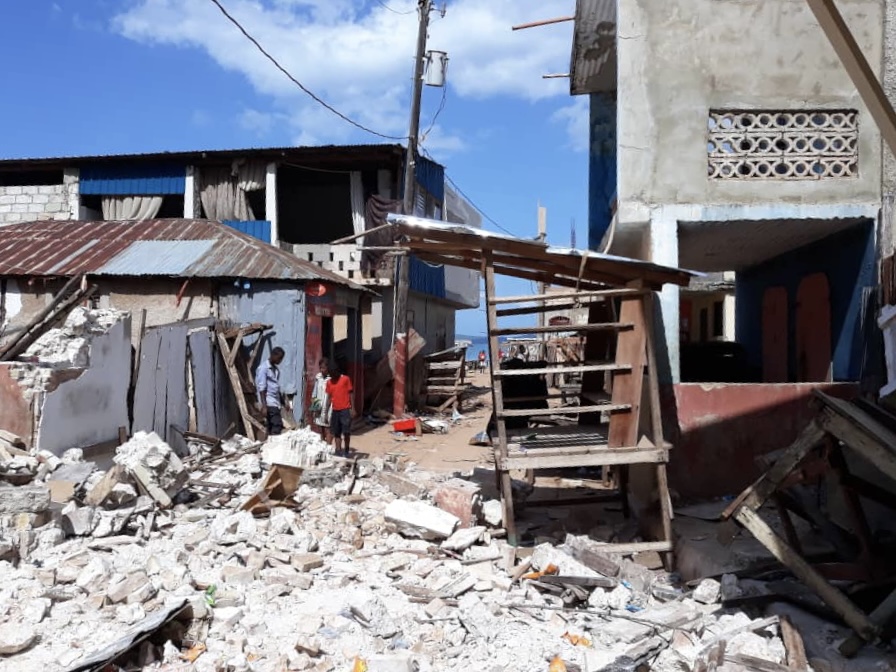
Last updated:
2021 Haiti Earthquake and Tropical Storm Grace

Overview
Just before 8:30 a.m. ET on Aug. 14, an M7.2 earthquake struck the southwest of Haiti in the mountains between the Nippes Department and Sud Department. This earthquake occurred at a depth of only 6.2 miles (10 km), which is critical because shallow earthquakes usually cause more damage.
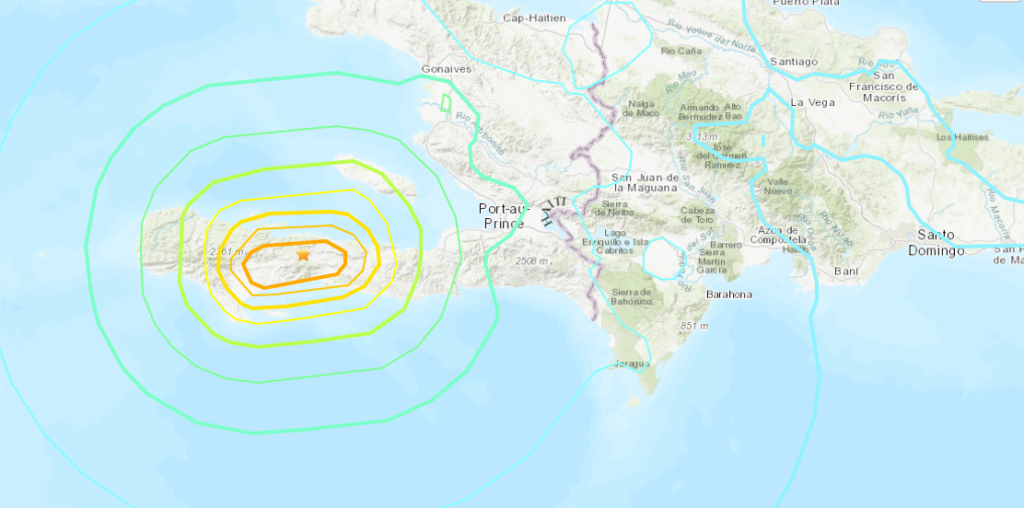
For comparison, the catastrophic 2010 earthquake took place approximately 46.6 miles (75 km) west of this earthquake and was an M7.0 that occurred at a depth of 8.1 miles (13 km). The damages from this earthquake are similar to 2010, albeit on a smaller scale due to the more rural geography and the smaller population at the epicenter. Just under a million people live within 31 miles (50 kilometers) of the epicenter, and about 234,000 live within nine miles (15 km).
Haiti also experienced a direct hit from Tropical Depression (TD) Grace overnight on Aug. 16. International humanitarian and response teams had to reduce many of their operations, especially the air-bridge used to distribute supplies. Those who had lost homes or remained outside fearing an aftershock huddled under tarps or tried to find shelter elsewhere.
Hundreds of landslides occurred in the impacted area. The most significant landslide blocked the major national highway between Jeremie and Les Cayes, hampering travel for rescue and aid efforts. TD Grace triggered additional landslides as destabilized soil got wet.
According to the United Nations Office for the Coordination of Humanitarian Affairs (UN OCHA), “The back-to-back disasters are exacerbating preexisting vulnerabilities. At the time of the disaster, Haiti is still reeling from the 7 July assassination of President Jovenel Moïse and still facing an escalation in gang violence since June that has affected 1.5 million people, with at least 19,000 displaced in the metropolitan area of Port-au-Prince. The compounded effects of an ongoing political crisis, socio-economic challenges, food insecurity and gang violence continue to greatly worsen an already precarious humanitarian situation. Some 4.4 million people, or nearly 46 per cent of the population, face acute food insecurity, including 1.2 million who are in emergency levels (IPC 4) and 3.2 million people at crisis levels (IPC Phase 3). An estimated 217,000 children suffer from moderate-to-severe acute malnutrition.”
(Photo courtesy of CORE)
The World Bank said, “With a Gross Domestic Product (GDP) per capita of US $1,149.50 and a Human Development Index ranking of 170 out of 189 countries in 2020, Haiti remains the poorest country in the Latin America and Caribbean region and among the poorest countries in the world … In addition to the challenges posed by the pandemic and the political stalemate, Haiti remains highly vulnerable to natural hazards, mainly hurricanes, floods and earthquakes. More than 96% of the population is exposed to these types of shocks.”
According to the World Food Programme, 77% of people in the affected area live in poverty. This increases their challenges in recovering from the disasters.
Haiti has also been overrun by gang violence and plagued by civil unrest, food insecurity, low education rates and cholera. This led Human Rights Watch (HRW) to state, “Protracted political instability and gang violence in 2020—often with state ties—contributed to the Haitian government’s inability to meet the basic needs of its people, resolve long-standing human rights problems, and address humanitarian crises.”
HRW also said:
- “Over 140,000 families displaced by Hurricane Matthew in 2016 still need decent shelter.
- Since the 2010 earthquake, nearly 33,000 people still live in displacement camps and at least 300,000 live in an informal settlement without government oversight. Authorities have not provided assistance to return or resettle them, or to ensure their basic rights in the settlement.
- The country’s most vulnerable communities face environmental risks, including widespread deforestation, industrial pollution, and limited access to safe water and sanitation.
- According to international agencies, some 4.1 million Haitians—more than a third—live with food insecurity, and 2.1 percent of children suffer severe malnutrition.
- Low rainfall, exacerbated by rising temperatures due to climate change, chronically affects much of the country.
- Since its introduction by UN peacekeepers in 2010, cholera has infected more than 819,000 people and claimed nearly 10,000 lives.
- Over a third of the population lacks access to clean water and two-thirds has limited or no sanitation service.
- Just under half of Haitians age 15 and older are illiterate. The quality of education is generally low, and 85 percent of schools are private, charging fees often too high for low-income families.
- Unrest and the pandemic kept 70 percent of Haitian children from classes throughout the school year. From September through November 2019, instability kept an estimated 3 million children out of school, and in March, the pandemic closed schools for five months. Prior to the pandemic, Haiti already had 500,000 school-age children out of school.”
In addition, as with all countries in the world, Haiti has been affected by the COVID-19 pandemic. As of Nov. 9, Haiti has reported 24,233 cases and 702 deaths. Testing is not (and has not been) a priority, so these numbers are likely severe underestimations. Haiti did not receive any vaccines until July 13, just one month before the earthquake. As a result, as of Nov. 5, only 0.49% of residents have received one dose, and 0.34% have been fully vaccinated.
Latest Updates
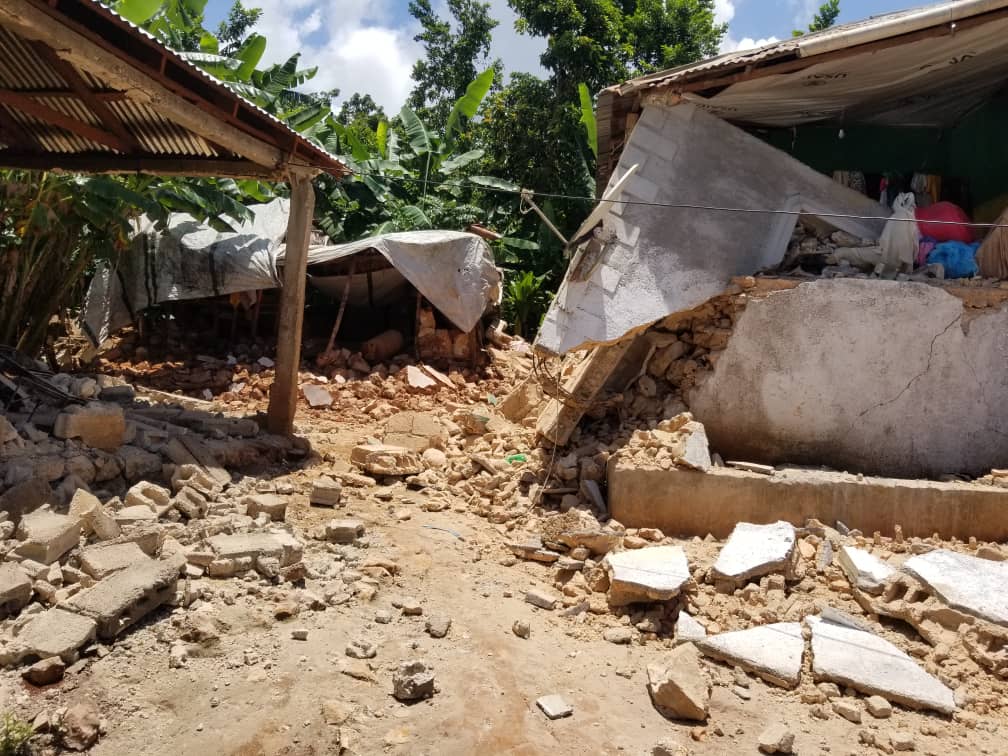
An urgent need to support earthquake-hit communities in Haiti
What is the impact on communities?
As of Sept. 6, the Haiti Civil Protection Directorate (DPC) reported that 2,248 people have died, and 12,763 people were injured. At that time there were still 329 people missing and no updates have been made since to that number. The DPC also reported more than 130,000 houses destroyed or damaged and “enormous damage” to multiple roads and four ports. There is a particular concern for the wellbeing of children, especially girls who the earthquake and subsequent hurricane have orphaned. The New Humanitarian reported that aid is slowly reaching those who need it, but is being challenged by gang activity, increasing cargo costs and other challenges.
UNOCHA says, “As access to food and purchasing power declines, nearly 1 million people – about 45 per cent of the population – in all 4 departments in Grand-Sud will experience high levels of acute food insecurity (IPC Phase 3 or higher) between September 2021 and February 2022, including nearly 320,000 people in Emergency (IPC Phase 4), an increase of 25 per cent compared to the same period in 2020. Response in rural areas, particularly on much needed livelihood inputs, is challenged by access constraints, creating potential risks for a rural exodus. Beyond the delivery of humanitarian assistance, focus must immediately be placed on scaling up early recovery and supporting livelihood activities. Rapid Gender Analysis indicates 43 per cent of community leaders and 75 per cent of youth say that [Gender-Based Violence] has increased after the earthquake, while 70 per cent of women and men’s fear of sexual violence has intensified post-earthquake. Around 212,000 people have lost access to safe drinking water services in the aftermath of the earthquake. Gang-related activities intensifies along national road #2, threatening to once again cut off access to the southern peninsula from Port-au-Prince, while fuel shortages and insecurity disrupt the distribution of life-saving relief supplies.”

Who was affected and in what ways?
Thousands of people are now homeless, and there continues to be an urgent need for shelters, which is hindered by the amount of damage and the pandemic. About 120,000 people require safe water, a high priority because Haiti only recently resolved the 2010 cholera epidemic. Unaccompanied – often orphaned – children are also a significant concern.
There are about 140 hospitals or health centers in the area of impact. It is reported that four were destroyed, and 32 experienced structural damage; 12 of those were extremely damaged. These hospitals continue to be short on supplies, including equipment and medicine, because of the volume of need.
According to UNICEF, in the Sud Department, “94 of the 255 schools have either sustained damages or been completely destroyed.” In Grand’Anse, 63 schools were destroyed and 39 more sustained damage. As in many countries, schools in Haiti are not just a place of learning and socialization, but also an opportunity to access health services and nutritional programs.
The most critical need at this time is an effective and coordinated response that takes into account the lessons learned from the 2010 quake, including those related to secondary disasters, including the Cholera outbreak, sexual assaults and “stuff” being donated. In 2010, donations included breast milk that spoiled, a box of frisbees mailed from Germany, winter clothes, tuxedos and energy drinks. It is estimated that 60% of in-kind donations are wasted.
According to ACAPS, the key considerations to keep in mind are: “The impact of the earthquake is going to aggravate pre-existing needs and vulnerabilities caused by political instability, recurring violence, food insecurity, and the COVID-19 outbreak. Haiti has high humanitarian constraints. Access has been deteriorating because of the escalating insecurity since the beginning of 2021. Damage to telecommunication networks delays the transmission of information for humanitarian organisations. Roads were damaged, adding a constraint to humanitarian access.”
Emergency basic needs
Emergency basic needs will continue to be needed for years because of the high pre-existing needs in Haiti. This includes food, shelter, hygiene items, cash assistance, tarps, rebuilding supplies, water, PPE and COVID-19 supplies.
Emergency health and psychological first aid
Emergency health and psychological first aid are desperate needs. Many of the victims of the 2021 earthquake also lived through the 2010 earthquake and Hurricane Matthew in 2016 and will require significant mental health and emotional support. There will also need to be psychosocial support for front-line responders – both international and Haitian. Given the loss of a high number of churches, a critical component of Haitian society, emotional disaster spiritual care is also important.
Protection
Protection initiatives to protect everyone’s safety, especially women and girls from violence including gender-based violence. All at-risk populations including the elderly, people living with disabilities, orphaned children need to have protection efforts instituted.
Rebuilding
Rebuilding will include infrastructure (WASH, electrical, communications, transportation, etc.) and businesses, homes, schools, health facilities and churches. This will be ongoing for many years as there are still people homeless from the 2010 earthquake and 2016’s Hurricane Matthew.
Livelihood restoration
Livelihood restoration is also important and will be an ongoing concern. Businesses were destroyed, including some of the hotels in tourist areas, a critical component of the Haitian economy. Given the high levels of existing poverty, there will be a need for the development of new revenue-generating activities.
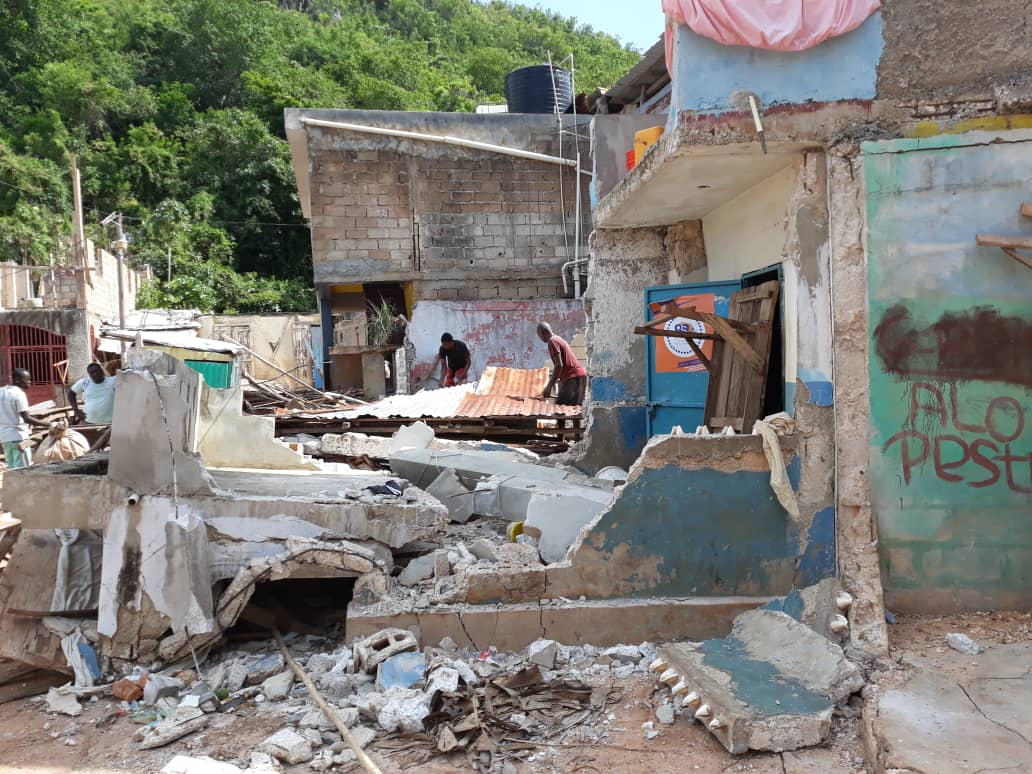
The CDP Haiti Earthquake Recovery Fund supported communities across Haiti as they worked to rebuild and recover from the earthquake.
Contact CDP
Recovery updates
If you are a responding NGO or a donor, please send updates on how you are working in this crisis to tanya.gulliver-garcia@disasterphilanthropy.org.
We welcome the republication of our content. Please credit the Center for Disaster Philanthropy.
Donor recommendations
If you are a donor looking for recommendations on how to help in this crisis, please email regine.webster@disasterphilanthropy.org.
Philanthropic and government support
The CDP Haiti Earthquake Recovery Fund supported families and entire communities through targeted grantmaking that prioritized needs identified in collaboration with local partners. With an equity lens and an emphasis on medium- and long-term recovery, CDP worked to identify gaps in recovery funding to help direct financial and technical support where it is needed most.
To date, CDP has made three grants through the Haiti Earthquake Recovery Fund:
- AVSI-USA received $159,876 to mitigate the harmful effects of the earthquake on children by providing physical and psychosocial protection, promoting child development through informal education programs and reactivating child protection networks.
- Catholic Relief Services received $200,000 to implement a Haiti Earthquake recovery project focused on livelihoods and hygiene promotion.
- The Haiti Development Institute received $249,997 to bring resources to earthquake-affected communities through local organizations to equip and empower them to help earthquake victims cope in the short term, rebuild their lives by repairing homes and community infrastructure, and restore livelihoods by replacing income-generating assets and repairing agricultural infrastructure. The project aims to ensure that affected communities are engaged in the disaster response as agents rather than objects of humanitarian assistance and to increase their capacity to plan and manage disaster risk.
The United Nations and its partners launched a flash appeal on Aug. 25 to raise $187.3 million, “urgently needed to provide vital relief assistance to more than 800,000 people affected by the devastating earthquake in Haiti, including shelter, water and sanitation, emergency healthcare, food, protection and early recovery.” This funding will target 500,000 of the most vulnerable people impacted by the earthquake.
UNOCHA says, “On 10 September, the Government of Japan announced a $3.25 million in Emergency Grant Aid for Haiti to be distributed to WFP, IOM, UNICEF and IFRC. The Central Emergency Response Fund (CERF), having already contributed $8 million to fund life-saving multi-sectoral response activities, approved an additional $4 million request for Haiti. The CERF allocation will allow for ongoing projects to be scaled up to address needs emerging from multiple simultaneous crises, including $2 million to bolster shelter, logistics and security operations for the earthquake response and $2 million to support the joint Government and UN relocation plan for hundreds of displaced people forced into informal displacement sites due to escalating gang violence in the Port-au-Prince metropolitan area.”
The European Union (EU) issued $4.07 million (€3 million) in emergency humanitarian aid on top of its existing commitments to the country. “To ensure the fastest possible intervention, EU funds will be implemented by humanitarian partners already active in the emergency response and will support and strengthen their capacity to swiftly provide humanitarian aid to the most vulnerable Haitians. The funding will address the most immediate needs such as the provision of medical assistance to local overwhelmed hospitals, water, sanitation and hygiene services, shelter and protection services for the most affected and disadvantaged communities.”
CDP hosted a webinar on Aug. 19 called “Disaster in a Crisis Zone: Understanding the Impact of Haiti’s Earthquake.” The key takeaways from the speakers were:
- ‘As local as possible, as international as necessary.’ This humanitarian principle that Sebastian Rhodes Stampa of UNOCHA shared is important to remember. We want to rely on local knowledge and capacities. We want to reinvigorate the local economy as much as possible, and importing goods, especially to an island, can be very expensive or even inappropriate. If the goods exist locally, buy them there. If not, bring them in but think consciously about it – for example, use water buffalos and solar-powered water filtration systems instead of pallets of bottled water.
- Find and fund local leaders. If you are funding an American-based 501(c)(3) find out who their Haitian partners are and ask about salaries and support. What is the proportion of Haitians to international staff on the team? It is critical to value and elevate local voices and local leaders and equip them with the resources they need to lead their country.
- Invest in an ecosystem. Aid should be about ending the need for aid. This means taking a wide view and looking at all sectors of society.
- You’re in a marathon, but it’s still a race. It is important that funders invest in mid- and long-term recovery. People were still homeless before the earthquake, not just from Hurricane Matthew in 2016 but also from the 2010 earthquake. That should not be the situation 11.5 years after a disaster and it’s not what we want to see when we look forward to 2032. At the same time, there are immediate and essential basic needs that require emergency funding.
Resources

Earthquakes
Striking without warning, earthquakes often are among the most devastating disasters. Caused by the movement of plates along fault lines on the earth’s surface, earthquakes often leave a monumental path of instant death and destruction.
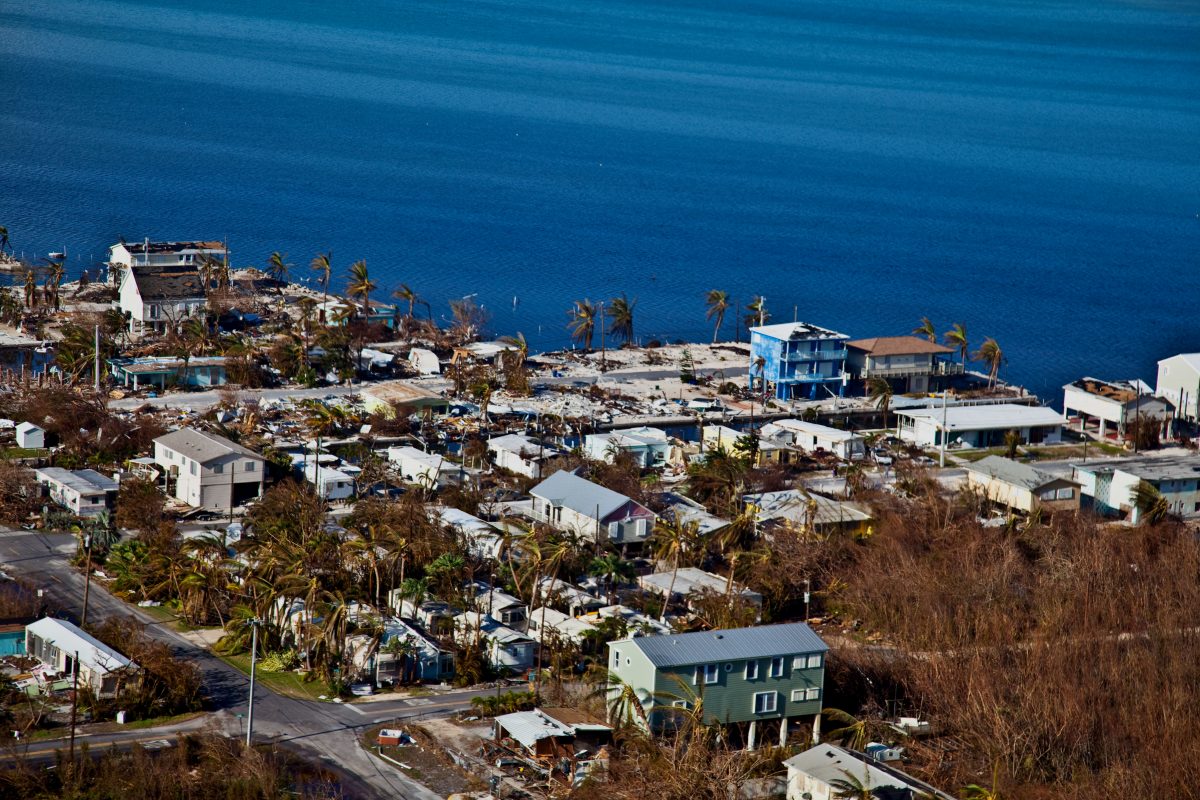
Hurricanes, Typhoons and Cyclones
Hurricanes, also called typhoons or cyclones, bring a triple threat: high winds, floods and possible tornadoes. But there’s another “triple” in play: they’re getting stronger, affecting larger stretches of coastline and more Americans are moving into hurricane-prone areas.
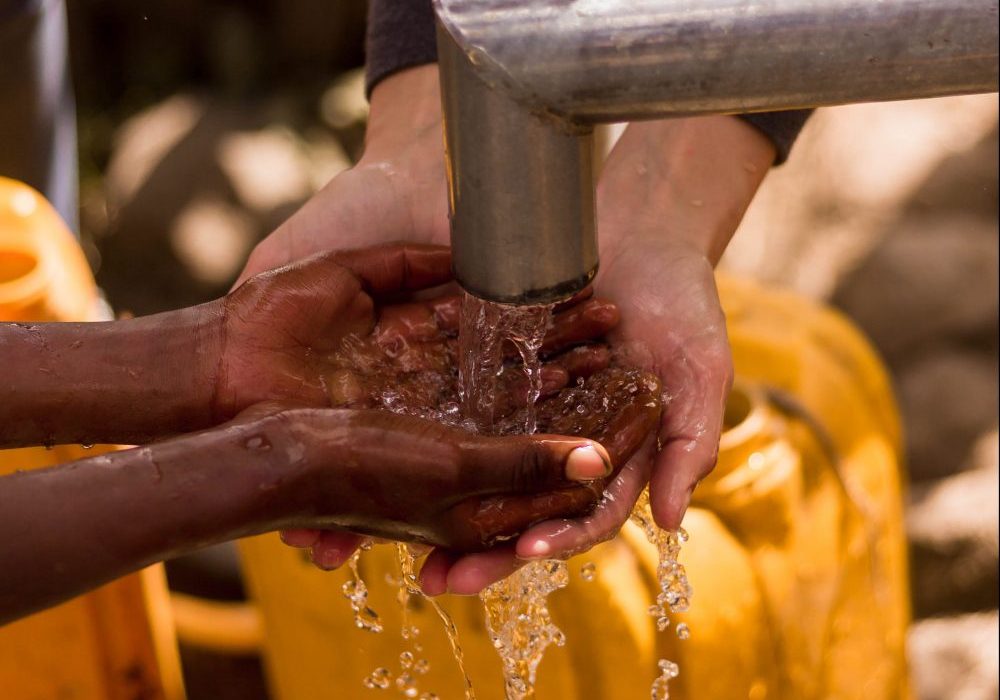
Water, Sanitation and Hygiene (WASH)
Water is one of the most necessary elements for life, yet according to the World Health Organization/UNICEF, 2.1 billion people lack access to safely managed drinking water. In addition, 4.5 billion people lack safely-managed sanitation facilities. Water, sanitation and hygiene (WASH) principles are of tremendous concern in everyday life, but can be heightened during an emergency or disaster.